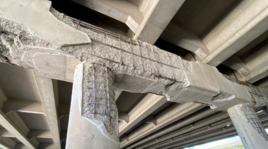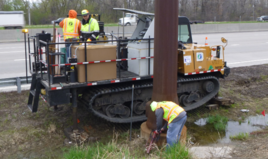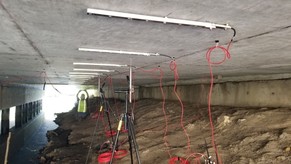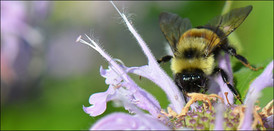|
Transportation Research Update
 Estimating Corrosion of Embedded Steel Rebars in Bridge Structures

Steel rebar reinforces concrete bridge structures. Harsh weather, road salt and age can lead to corrosion of the embedded steel rebars. Rust has a higher volume than steel and results in expansion-induced concrete damage. Knowing how much of the rebar remains intact is necessary to estimate any changes to structural capacity. Accurate measurements of the steel loss due to corrosion, however, are difficult to obtain, especially when the rebar is still partially or fully embedded in concrete.
New research has produced a tool to help bridge inspectors document damage, leading to better structural evaluation. Researchers examined materials and conditions specific to Minnesota that can lead to steel corrosion. They obtained rebar samples during a bridge repair to assess the extent of steel loss and implications for structural capacity. From this data, they developed and calibrated models to predict the section loss of rebars. These models and associated guidance tables will inform bridge maintenance actions, such as the inclusion of supplemental substructure strengthening with concrete repairs.
|
Nondestructive Detection of Pile Length for High-Mast Light Towers

Hundreds of high-mast light towers across Minnesota sit on foundations secured by piles embedded deeply underground. The pile depths under these light towers need to be inspected to ensure current design standards are met. These inspections are challenging as some towers have been in place for several decades and construction records may not exist. Retrofitting or replacing light towers is costly.
New MnDOT research has produced a testing method to determine pile depth without digging or dismantling. Using above-ground vibration and understanding the layers of soil in which the pile is embedded, researchers can measure seismic waves bouncing off the length of the pile. This data, combined with 3D simulations and machine learning, allows for an accurate estimation of the pile depth. This method can be executed for one-eighth of the cost of retrofitting or replacing a tower. Armed with this knowledge, MnDOT can cost-effectively prioritize which high-mast light towers need attention.
|
Updating Load Ratings for Shingle Creek Slab-Span Bridges

The corridor along I-94/I-694 across Shingle Creek is a critical freight transportation route in Minnesota. Some trucks, however, are forced to take a 15-mile, more congested detour if they exceed the bridges’ legal weight limit. MnDOT can issue overweight permits based on several factors that ensure safe passage. Load ratings calculated according to federal and state guidance, however, prevent larger trucks from being permitted. New MnDOT research has the potential to ease this burden.
An in-depth analysis of the Shingle Creek bridge load capacity found that existing load rating factors for the Shingle Creek bridges are overly conservative. After a thorough visual inspection, researchers performed numerous live loading tests with trucks, and evaluated various measures of how the bridge and bridge materials responded. Using this field data in conjunction with a complex computational model as well as a simpler numerical model, researchers generated more representative load distribution factors than were previously calculated. MnDOT now has more flexibility in permitting overweight trucks to cross the Shingle Creek bridges and tools to refine load ratings for other bridges.
|
Improving Pollinator Habitat Through Cost-Effective Roadside Vegetation

Pollinating insects keep flowering plants and crops alive. Many pollinators, however, are threatened with extinction, including the rusty patched bumble bee and the monarch butterfly. Local agencies and MnDOT must revegetate roadsides after construction to provide road stability, stormwater filtration and visual appeal. Revegetation also offers a significant opportunity to create pollinator-friendly habitat. New research recommends strategies for agencies across Minnesota to support these important pollinators.
Researchers investigated the relationship between roadside vegetation and pollinating bumble bees and butterflies. Using existing pollinator habitat maps, they identified the areas most likely to support these specific pollinators. They also explored the differences in how native and nonnative vegetation provides supportive habitat, and found that a diversity of flowering plants is most important for attracting pollinators. Plants native to the area can be important for many reasons. Observing revegetated sites of varying ages, they developed planting and maintenance recommendations for local agencies and MnDOT to cost-effectively provide visually appealing pollinator habitat.
|
Economic Effects of Complete Streets Projects on Minnesota’s Main Streets

Complete Streets is a national initiative to design and maintain roadways to be safe and accessible for all users, including drivers, pedestrians, cyclists and those with mobility challenges. MnDOT implements this policy in reconstruction projects on all of its highways, including those running through smaller cities. Since these roadways often serve as commercial main streets, construction projects may impact the economic vitality of the city. While improving mobility and access to the transportation system can be beneficial in the long run, the economic impacts during construction can be challenging for businesses. New research has given MnDOT a greater understanding of the impacts, strategies to work with local officials and tools to evaluate the economic impacts of road construction in small cities.
Researchers developed case studies in nine small cities with Complete Streets road projects. Interviewing MnDOT staff, city officials, business representatives and others in each location, they gathered a range of perceptions regarding challenges and benefits during and following construction. Coupled with evaluation metrics MnDOT can use to understand and communicate economic impacts, research results will help to ensure small cities are gaining the maximum benefit from road construction on their main streets.
|
MnDOT Research in the News
-
Snow Fences can Save Money, Lives, and Help the Environment, CBS Minnesota
-
Lowering Deer-Related Car Accidents in Minnesota, MSP Magazine
-
Study On Deer Vehicle Crashes, Fox21
-
‘He was fast … he ran you right over’: what it’s like to get hit by an SUV, The Guardian
-
University of Minnesota Professor: Let's Plan to Make Commuting a Happy Experience, Star Tribune
-
Telecommuting Study Reveals Surprises and Challenges, West Central Tribune
-
Cyclists Have Happiest Commute, Shows US Smartphone App, Forbes
|
|
|
MnDOT invites and encourages participation by all people in their programs, services and activities.
- If you need an ASL, a foreign language interpreter, or documents in an alternative format (such as braille, large print or in a different language) at no cost, please email your request to Janet Miller at ADArequest.dot@state.mn.us or call 651-366-4720. Relay service: 711.
- If you need any another reasonable accommodation to participate (such as seating modification or auxiliary aids), please email your request to Accessibility.DOT@state.mn.us or call 1-833-400-8432. Relay service: 711.
|
|
|
|
|